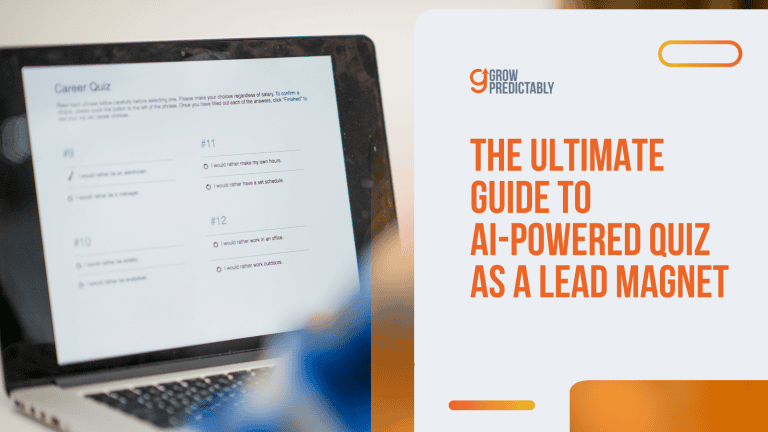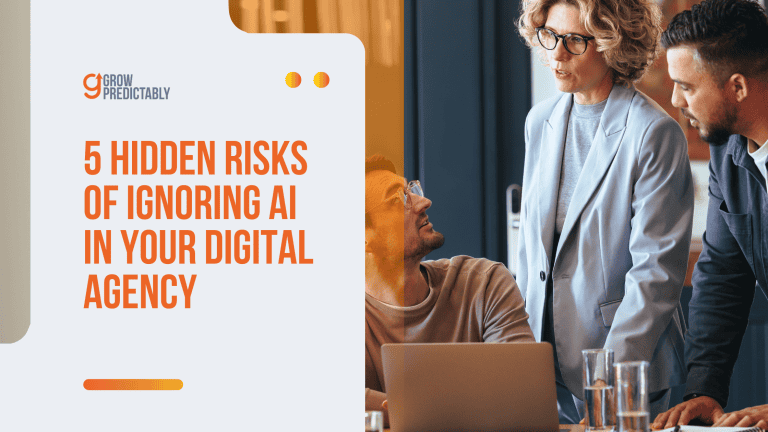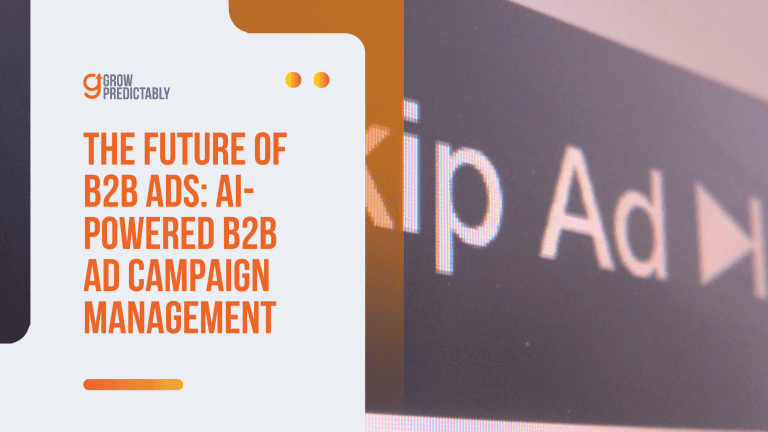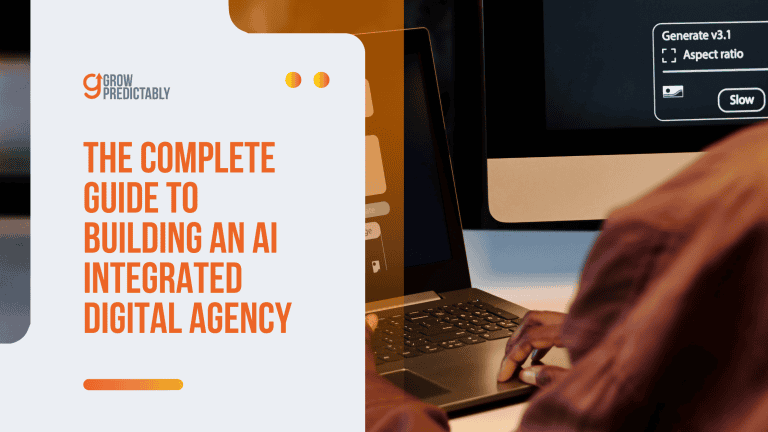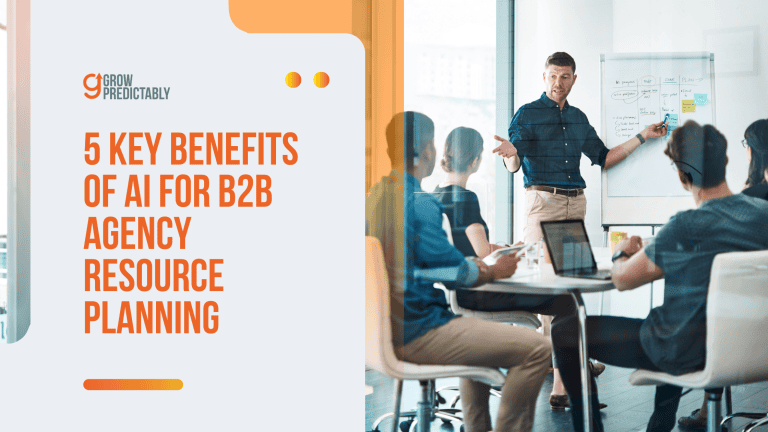AI-Based B2B Advertising Management: What Works Now
B2B marketers waste up to 30% of ad spend due to poor targeting.
That’s cash burned—not invested.
AI-based B2B advertising management flips that formula.
No more guessing who’s ready to buy.
No more manual targeting for hours.
Smart systems now track digital behavior, patterns, and timing—so the right message hits the right account right when it matters.
Want to drop cost-per-lead from $280 to $95?
Let’s pull back the curtain on how it’s done.
But first—ever wonder what signals actually tell AI that a company is ready to buy?
Keep reading.
TL;DR
AI-based B2B advertising management enhances targeting by using predictive analytics and behavior tracking. Implementing AI tools, such as 6sense and Salesforce Einstein, can streamline processes, reduce wasted ad spend, and improve ROI. Ensure seamless integration with existing systems for optimum performance.
KEY TAKEAWAYS
- Start by mapping your ideal client profile and use AI tools like 6sense to track behavior patterns and enhance targeting accuracy.
- Ensure seamless data flow by connecting your AI systems to your CRM and standardizing customer-related information for consistency.
- Regularly measure performance metrics such as cost per qualified lead and time to conversion to optimize AI-driven strategies and demonstrate clear ROI.
What Is AI-Based B2B Advertising Management?
Advertising management is essentially about strategically planning, implementing, and overseeing advertising in marketing campaigns to ensure they effectively reach the desired audience and achieve business objectives.
It involves selecting the right channels, including Google ads, incorporating search engine optimization strategies, crafting engaging messages, and continuously analyzing performance metrics to optimize efforts and maximize ROI.
Did you know B2B marketing can lead to wasting up to 30% of ad spend due to poor targeting?
Artificial intelligence is giving businesses a competitive edge in how they connect with the target audience.

Let’s unpack what makes modern digital marketing and B2B ad management tick and why it matters for your agency.
Picture this: instead of spending hours manually picking who sees your ads, B2B marketing can be revolutionized by AI technologies.
Smart systems spot patterns in how businesses browse online, what they’re researching, and when they’re ready to buy.
This tech works like a skilled matchmaker, connecting your message with the right business decision-makers at just the right moment.
Here’s what makes AI powered tools work.
1. Smart Lead Spotting
Think of predictive analytics like having a super-smart assistant who notices when companies start researching solutions.
When your target audience reads multiple articles about HR software or visits pricing pages., the system flags them as interested buyers.
2. Behavior Tracking That Makes Sense
The tech watches how businesses interact with your content, spotting signs they’re getting ready to buy.
It’s like having a crystal ball that shows you which companies are most likely to need your help soon.
3. Smart Learning Systems
These tools enhance B2B marketing and empower both marketing and sales teams by getting smarter over time.
They pick up on which ads work best for different types of companies, helping you spend money where it counts.
Quick wins you can expect:
- Cut wasted ad spend by targeting only interested businesses
- Speed up your sales process by focusing on ready-to-buy companies
- Show clear ROI to clients faster
Want to know something cool?
One agency saved over 200 hours every quarter by letting smart tools handle their ad targeting.
Remember: You don’t need to be a tech wizard to make this work.
Start small, focus on one area where your marketing strategies are wasting time or money, and let the tech help you make data driven decisions.
Requirements:
- Break down all paragraphs into one-sentence paragraphs.
- Apply hierarchical Markdown formatting using ## and lower-level headings to structure the content.
- Do not use the top-level heading (#) in the formatting.
5 of The Best AI Tools for B2B Advertising
For many B2B agency owners, ad spend will always be a top concern when it comes to advertising.
But with artificial intelligence in your disposal? You can significantly improve lead generation and cut down your agency’s cost per lead in just a matter of weeks.
Let’s break down which tools and marketing strategies can drive similar wins for your agency.
Top B2B AI Advertising Tools Compared
Here’s a straightforward comparison of the market’s leading platforms:
| Tool | Sweet Spot | Starting Price | Stand-Out Feature |
|---|---|---|---|
| 6sense | Enterprise ABM | $20K/year | Buying stage prediction |
| Demandbase | Mid-market targeting | $15K/year | Website personalization |
| Salesforce Einstein | CRM integration | Custom | Native Salesforce fit |
| Mutiny | Website conversion | $2K/month | Quick testing tools |
| Drift | Chat automation | $2.5K/month | Real-time engagement |
Here’s what these B2B marketing tools do best:
- 6sense shines at finding hidden buyers before they reach out. Picture having a radar that spots companies researching your solutions.
- Demandbase excels at personalizing web content based on company size and industry. Your site changes dynamically for each visitor.
- Salesforce Einstein works magic if you’re already using Salesforce, predicting which leads need immediate attention.
- Mutiny makes quick work of testing different messages for different audiences. Think A/B testing on steroids.
- Drift enhances customer interactions by connecting you with hot prospects right when they’re browsing your site.
The Real Impact on Your Customer Journey
Here’s where these tools fit in your funnel:
Awareness Stage
- 6sense spots interest signals
- Demandbase identifies target accounts
Consideration Stage
- Mutiny personalizes landing pages
- Drift starts conversations
Decision Stage
- Einstein predicts close rates
- Demandbase tracks buying committee engagement
Quick-Start Guide
- Pick ONE tool based on your biggest pain point
- Run a 90-day test
- Use AI powered insights and Google ads analytics to track before/after metrics
- Scale what works
Watch Out For
❌ Don’t buy based on features alone
❌ Skip long-term contracts initially
❌ Avoid tools that need huge data sets to start
In the coming sections, we’ll dive into implementing these tools without breaking your workflow or your bank.
But first, you need to know exactly how to map them to your customer avatar…
Remember: The right tool isn’t about fancy features – it’s about what gets results for YOUR agency’s unique needs.
How Do You Introduce AI Into Your B2B Advertising Strategies?
I want you to imagine your perfect client.
Now think of reaching hundreds just like them without the endless manual work…
That’s what happens when you blend AI with your Customer Avatar Canvas.

Let’s break this down into bite-sized pieces you can use right now.
First, map your ideal client profile (ICP) on the Canvas:
- Pain points
- Goals and values
- Decision triggers
- Communication style
- Purchase behaviors
Now here’s where AI supercharges your targeting:
1. Behavior Tracking
6sense scans digital footprints across the web, finding accounts that match your ICP’s behavior patterns.
When a potential client reads about your service category or checks out competitor websites, the AI flags them as ready for engagement.
2. Smart Personalization
Feed your Canvas data into Salesforce Einstein to craft messages that enhance customer interactions and speak directly to each prospect’s needs.
The AI learns which pain points resonate most and adjusts your messaging in real-time.
3. Website Magic
Mutiny takes your visitor data and instantly tweaks your website content.
When a CFO from a mid-size tech company lands on your page, they’ll see case studies and ROI metrics that matter to them specifically.
Founder’s Checklist:
□ Is your CRM data clean and current?
□ Have you set clear conversion goals?
□ Do your ad audiences match your AI segments?
□ Are your tracking pixels and Google Analytics properly installed?
Watch Out For:
- Trusting AI recommendations blindly
- Missing industry-specific nuances
- Poor sales and marketing alignment
- Incomplete customer data
Remember: AI tools amplify your strategy – they don’t replace it.
Start with one clear ICP segment, perfect your approach, then scale.
Ready to see this in action?
Here’s what happens when your data isn’t playing nice with your campaign tracking… but we’ll get to that solution in the next section.
3 Common Challenges in AI-Based B2B Advertising
You might be using AI tools—but are you making one of these three fatal mistakes?
Let’s tackle the key hurdles standing between you and successful AI-driven B2B advertising, plus how to jump right over them.
1. Data Privacy & Compliance
Getting excited about AI capabilities is great, but protecting your data is non-negotiable.
The EU AI Act and CCPA can affect how you leverage AI as your competitive edge as it sets strict rules about how you handle customer information.
Quick Fix:
Start a monthly compliance check.
Look at:
- Where your data lives
- How it moves between tools
- Who can access it
- What permissions you’ve documented
Create a simple spreadsheet tracking these points and review it monthly with your team.
2. AI Bias & Model Opacity
AI tools can pick up hidden biases, leading to skewed targeting or unfair ad distribution.
Think of it like a mirror – it reflects what we feed it.
Quick Fix:
Run these checks:
- Test campaigns across different demographics
- Compare results between various industry segments
- Watch for unusual patterns in targeting
- Keep humans in the review loop
3. Integration Friction
Getting AI tools to play nice with your existing stack can feel like herding cats.
But integrating artificial intelligence smoothly is worth the effort.
Quick Fix:
- Map your data flows on paper first
- Test one connection at a time
- Document what works (and what breaks)
- Build backup processes for critical functions
As Paul Roetzer, Founder of Marketing AI Institute puts it, agencies that manage AI governance proactively gain client trust—and higher margins.
For agency founders, fixing these issues early means:
- Smoother client pitches
- Faster campaign launches
- More reliable analytics
- Better client retention
Ready to check your AI readiness?
Run this quick 3-question audit:
- Have you documented your AI data handling process?
- When did you last test your AI tools for bias?
- Can you explain how your AI makes decisions to clients?
If you answered “no” to any of these, it’s time for an AI health check.
Just to be clear, these challenges aren’t purely roadblocks – they’re opportunities to build stronger foundations for your agency’s future.
Measuring Success and ROI in AI-Driven B2B Advertising

Want to know if your AI investments are paying off?
Let’s dig into the numbers that matter.
Key Performance Metrics That Count
B2B advertising costs can add up fast.
Currently, marketing campaigns show an average cost per lead of $250 (Gartner, 2023).
But here’s the good news – when you bring AI and stay updated with market trends into your targeting mix, you can slash those costs by 40-60%.
Keep your eye on these core numbers:
- Cost per qualified lead
- Time to conversion
- Lead quality score
- Marketing spend efficiency
Making ROI Crystal Clear
Let’s make measuring returns straightforward.
Here’s your quick formula with AI powered tools for marketing teams:
ROI % = [(AI campaign revenue – AI costs) / AI costs] x 100
For example: If you spend $10,000 on AI tools and generate $30,000 in new revenue:
ROI = [($30,000 – $10,000) / $10,000] x 100 = 200% return
Real Results in Action:
A small 10-person agency improved customer engagement by pairing Demandbase’s smart targeting with Drift’s chat tools.
The result?
They bumped up their sales-qualified leads and improved lead generation by 83% without spending an extra penny.
Dashboard Must-Haves
Track these weekly:
- Lead source quality comparison
- AI vs. manual campaign performance
- Cost savings from automated tasks
- Client retention rates
Quick Wins You Can Show Your Clients
- Weekly lead quality scores
- Monthly cost-per-acquisition trends
- Quarter-over-quarter conversion improvements
- Year-on-year client growth patterns
Your quarterly business reviews just got easier – no more digging for success stories or scrambling for stats.
These numbers tell the story themselves.
Next up: We’ll show you how to keep these results strong as your tech stack grows.
But first, here’s a quick health check for your current tracking:
✓ Are your conversion tracking pixels firing correctly?
✓ Have you set up proper attribution windows?
✓ Do your dashboards auto-update with fresh data?
Remember: What gets measured gets managed.
Start tracking these metrics today, and you’ll see exactly where AI shines in your B2B advertising efforts.
Integrating AI Technologies With Your Existing B2B Marketing Tech Stacks
Is your new AI investment working as hard as it should?
Let’s make sure your chosen AI powered tools play nicely with your current tools.

Here’s a straightforward path to get your tech working together:
1. Connect Your Customer Data
Start by linking your AI systems to your digital marketing CRM.
For example, when you connect Salesforce AI Cloud to your main database, it automatically updates lead scores based on real behavior patterns.
Think of it like giving your marketing and sales teams a direct line to your customer insights.
2. Clean Up Your Data Flow
Make your data consistent across platforms by:
- Standardizing company names and contact info
- Setting up regular data cleaning schedules
- Creating unified customer profiles
Quick Win: One small agency founder set up AI powered tools like Zapier to connect Jasper with HubSpot.
Now their welcome emails write themselves with an AI content writer, cutting manual work from 5 hours to 1 hour per week.
3. Build Smart Workflows
Connect your AI tools to your marketing platforms in this order:
- Set up trigger events (like form submissions)
- Create automated response sequences
- Build feedback loops to improve targeting
Your Integration Checklist
Before going live, verify:
✔️ Data flows between systems
✔️ Team members completed tool training
✔️ Attribution tracking catches all touchpoints
✔️ Regular testing schedule exists
Remember: Good integration multiplies your results.
Bad integration just multiplies your headaches.
FAQs
Smarter Advertising Starts Now
Advertising doesn’t have to be a guessing game anymore.
You’ve now seen how AI-based B2B advertising management helps you identify warm leads, reduce cost-per-lead, shorten sales cycles, and boost client ROI—without drowning in manual work.
And if you feel like you’re juggling too many systems and not seeing enough return, this is your wake-up call.
You don’t need a massive tech team—you need the right AI, the right data, and the right strategy.
Ready to take the first step? Start using Customer Avatar Canvas and kick off your AI journey with clarity.
Before you jump back into running campaigns, take a moment to reflect:
What could your agency achieve if AI gave you back 200 hours a quarter?
The broader shift is happening now—those who adopt early won’t just survive, they’ll dominate.



